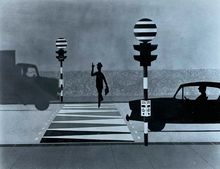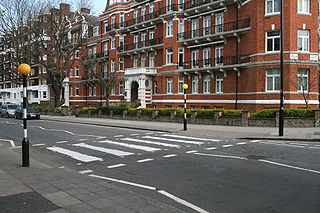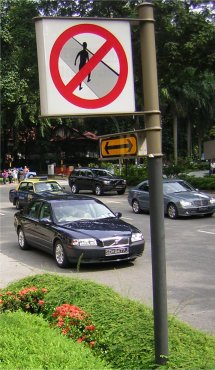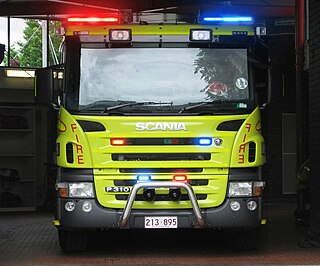This article needs additional citations for verification .(May 2012) |
The panda crossing was a type of signal-controlled pedestrian crossing used in the United Kingdom from 1962 to 1967.
Contents

This article needs additional citations for verification .(May 2012) |
The panda crossing was a type of signal-controlled pedestrian crossing used in the United Kingdom from 1962 to 1967.

In the early-1960s, the British Ministry of Transport, headed by Ernest Marples, was looking for a way to make pedestrian crossings safer under increasingly heavy traffic conditions. The successful zebra crossing design was not considered safe enough for busy roads and could create traffic delays as pedestrians crossed whenever they wanted. Off-the-shelf light-controlled systems were available but were too expensive for widespread use. Some cities had innovated with their own one-off crossings but the lack of standardisation was considered a safety issue. Furthermore, all existing signalled crossings tended to have two major drawbacks: stopping traffic for long periods of time and appearing to violate contemporary right-of-way law by signalling "Don't cross" to pedestrians (in reality: the 'Don't Cross' indication was not a legally enforceable instruction). [1]
The panda crossing was introduced in 1962 as an attempt to combine the best features of available and experimental crossing systems. The first public example was opened on 2 April of that year outside London Waterloo railway station. The majority of the initial sites used for this experiment were in Guildford where all thirteen existing crossings were converted, and in Lincoln where ten crossings were converted. Further sites across England and Wales increased the size of the experiment to more than forty sites in all. [2]

The layout was superficially similar to a traditional zebra crossing, with a painted area on the road announced by Belisha beacons. For distinction, the panda road pattern was different (triangles rather than stripes) and the beacons were striped, not plain. The main additions were the light signals on the beacon poles. The traffic signals consisted of two lamps, red and amber, while the pedestrians had a single signal displaying the word "Cross" when appropriate. [3]
In the idle state, no lights were lit. A pedestrian wanting to cross would press a button on the beacon pole and be instructed to wait by an illuminated sign near the button.

The system allowed for a pause between crossings in order to avoid traffic delays, and so the pedestrian might wait a while before anything happened. The amber traffic light would pulsate for a few seconds to inform motorists that someone was about to cross; a red light was then the signal to stop. At this point, the pedestrians' "Cross" signal began to flash. After a few seconds, the "Cross" light started to flash faster and the red traffic light was changed to a flashing amber (this "flashing" phase was considered distinct from the initial "pulsating" amber light).
[2] The "Cross" light flashed increasingly fast as crossing time ran out, and the traffic was allowed to proceed during the flashing amber phase if the crossing was clear. Eventually, all lights were extinguished as the crossing reset.
The panda crossing deliberately omitted any sort of "Don't cross" message for pedestrians in order to avoid breaching the aforementioned right-of-way laws. The measured pause between crossings helped to keep traffic flowing. The light sequence also prevented long delays by allowing traffic to move after a few seconds if nobody was crossing. However, despite its apparent rationality, the design was not a success. In particular, the distinction between the flashing and pulsating amber phases was subtle yet highly significant. [3]
By 1967 the panda crossing was a matter of concern for the Ministry of Transport, and so a new type of crossing, the X-way, was introduced. The new system was not phased in gradually by replacement, rather the pandas were removed seemingly as a matter of urgency. The replacement was so urgent that although the X-way lights replaced the panda crossing lights, the road initially retained the black-and-white triangular markings until they could be removed at a later date. The X-way itself soon disappeared when, in 1969, the modern-day pelican crossing was introduced.

A zebra crossing or a marked crosswalk is a pedestrian crossing marked with white stripes. Normally, pedestrians are afforded precedence over vehicular traffic, although the significance of the markings may vary by jurisdiction. They are known as "zebra" crossings as the stripes resemble the coat of a zebra.

A pedestrian crossing is a place designated for pedestrians to cross a road, street or avenue. The term "pedestrian crossing" is also used in the Vienna and Geneva Conventions, both of which pertain to road signs and road traffic.

A pelican crossing is a type of pedestrian crossing with traffic signals for both pedestrians and vehicular traffic, activated by call buttons for pedestrians, with the walk signal being directly across the road from the pedestrian. Pelican crossings are ubiquitous in many countries, but usage of the phrase "pelican crossing" is confined mainly to the UK and Ireland. The design was originally introduced in the United Kingdom; they are also found in the Isle of Man, the Channel Islands, Ireland, Indonesia and Australia. The crossings began to be phased out in Great Britain in 2016, being replaced with puffin crossings which have pedestrian signals above the call button rather than across the road.
Belisha beacon is a yellow-coloured globe lamp atop a tall black and white striped pole, marking pedestrian crossings of roads in the United Kingdom, Ireland, and other countries historically influenced by Britain, such as Hong Kong, Malta, and Singapore. The beacons were named after Leslie Hore-Belisha (1893–1957), the Minister of Transport who, in 1934, added beacons to pedestrian crossings, marked by large metal studs in the road surface. These crossings were later painted in black and white stripes, and thus are known as zebra crossings. Legally, pedestrians have priority on such crossings.

Traffic lights, traffic signals, or stoplights – also known as robots in South Africa and Namibia – are signalling devices positioned at road intersections, pedestrian crossings, and other locations in order to control the flow of traffic.

A puffin crossing is a type of pedestrian crossing in use in the United Kingdom.

Jaywalking is the act of pedestrians walking in or crossing a roadway if that act contravenes traffic regulations. The term originated in the United States as a derivation of the phrase jay-drivers, people who drove horse-drawn carriages and automobiles on the wrong side of the road, before taking its current meaning. Jaywalking was coined as the automobile arrived in the street in the context of the conflict between pedestrian and automobiles, more specifically the nascent automobile industry.

Emergency vehicle lighting, also known as simply emergency lighting or emergency lights, is a type of vehicle lighting used to visually announce a vehicle's presence to other road users. A sub-type of emergency vehicle equipment, emergency vehicle lighting is generally used by emergency vehicles and other authorized vehicles in a variety of colors.

Road signs in Sweden are regulated in Vägmärkesförordningen, VMF (2007:90), and are to be placed 2 metres from the road with the sign 1.6 m from the base for motorized roads. Except for route numbers, there are a maximum of three signs on a pole, with the most important sign at the top. All signs have a reflective layer added on selected parts of the sign as is custom in European countries; most larger signs also have their own illumination.
Traffic signal preemption is a system that allows an operator to override the normal operation of traffic lights. The most common use of these systems manipulates traffic signals in the path of an emergency vehicle, halting conflicting traffic and allowing the emergency vehicle right-of-way, thereby reducing response times and enhancing traffic safety. Signal preemption can also be used on tram, light-rail and bus rapid transit systems, to allow public transportation priority access through intersections, and by railroad systems at crossings to prevent collisions.
Road signs in Singapore closely follow those laid down in the traffic sign regulations used in the United Kingdom, although a number of changes over the years have introduced some slight deviations that suit local road conditions. Road signs in Singapore conform to the local Highway Code under the authority of Singapore Traffic Police.

In traffic engineering, there are regional and national variations in traffic light operation. This may be in the standard traffic light sequence or by the use of special signals.
A HAWK beacon is a traffic control device used to stop road traffic and allow pedestrians to cross safely. It is officially known as a pedestrian hybrid beacon. The purpose of a HAWK beacon is to allow protected pedestrian crossings, stopping vehicular traffic only as needed. The HAWK beacon is a type of traffic control alternative to traffic control signals and/or where an intersection does not meet traffic signal warrants.

The normal function of traffic lights requires more than sight control and coordination to ensure that traffic and pedestrians move as smoothly, and safely as possible. A variety of different control systems are used to accomplish this, ranging from simple clockwork mechanisms to sophisticated computerized control and coordination systems that self-adjust to minimize delay to people using the junction.

There are around 6,000 level crossings in the United Kingdom, of which about 1,500 are public highway crossings. This number is gradually being reduced as the risk of accidents at level crossings is considered high. The director of the UK Railway Inspectorate commented in 2004 that "the use of level crossings contributes the greatest potential for catastrophic risk on the railways." The creation of new level crossings on the national network is banned, with bridges and tunnels being the more favoured options. The cost of making significant reductions, other than by simply closing the crossings, is substantial; some commentators argue that the money could be better spent. Some 5,000 crossings are user-worked crossings or footpaths with very low usage. The removal of crossings can improve train performance and lower accident rates, as some crossings have low rail speed limits enforced on them to protect road users. In fact, between 1845 and 1933, there was a 4 miles per hour (6.4 km/h) speed limit on level crossings of turnpike roads adjacent to stations for lines whose authorising act of Parliament had been consolidated in the Railways Clauses Consolidation Act 1845 although this limit was at least sometimes disregarded.

The Slough experiment was a two-year road safety trial carried out in Slough, Berkshire, England, from 2 April 1955 to 31 March 1957. Different road safety innovations were tested to determine if they would reduce the number of road accidents. Amongst other innovations the experiment trialled the first linked traffic signals in the country, single yellow no-waiting lines, a keep left system for pedestrians and yield signs at junctions. The experiment also saw the first use of 20 mph and 40 mph speed limits in the UK. The experiment cost at least £133,100 and resulted in a 10% reduction in serious injuries and fatalities.

The United Kingdom has specific types of pedestrian crossing.
Designs of level crossings, where railway lines cross roads or other paths, vary country-to-country.
Traffic lights – devices positioned at road intersections, pedestrian crossings and other locations – control flows of traffic with social norms and laws created by the state. Traffic signals have to convey messages to drivers in a short period of time about constantly-changing road rules.

Crosswalks in the United States and Canada are normally found at intersections, though sometimes may be found mid-block. Crosswalk installations must follow the regulations specified in the Manual on Uniform Traffic Control Devices (MUTCD). At signalized intersections, crosswalks may have pedestrian signals which display symbols to mandate when pedestrians may cross the street.